NURS2006 Clinical Governance: A Report on Fall Prevention Strategies
VerifiedAdded on 2023/06/07
|9
|1907
|215
Report
AI Summary
This report investigates fall prevention as a critical nursing issue related to patient safety and healthcare quality, focusing on older adults. It reviews three relevant articles, evaluating the effectiveness of their interventions using the CASP checklist. The analysis covers studies by Shier, Trieu, and Ganz (2016), Robins et al. (2016), and Clemson et al. (2012), examining their methodologies, findings, and limitations. The report highlights the importance of exercise and population-based programs in fall prevention, the benefits of home-based and group-based interventions, and the effectiveness of lifestyle-integrated approaches. Ultimately, the report synthesizes these findings to provide insights into improving fall prevention practices within clinical governance frameworks. Desklib provides a platform to access similar solved assignments and past papers for students.
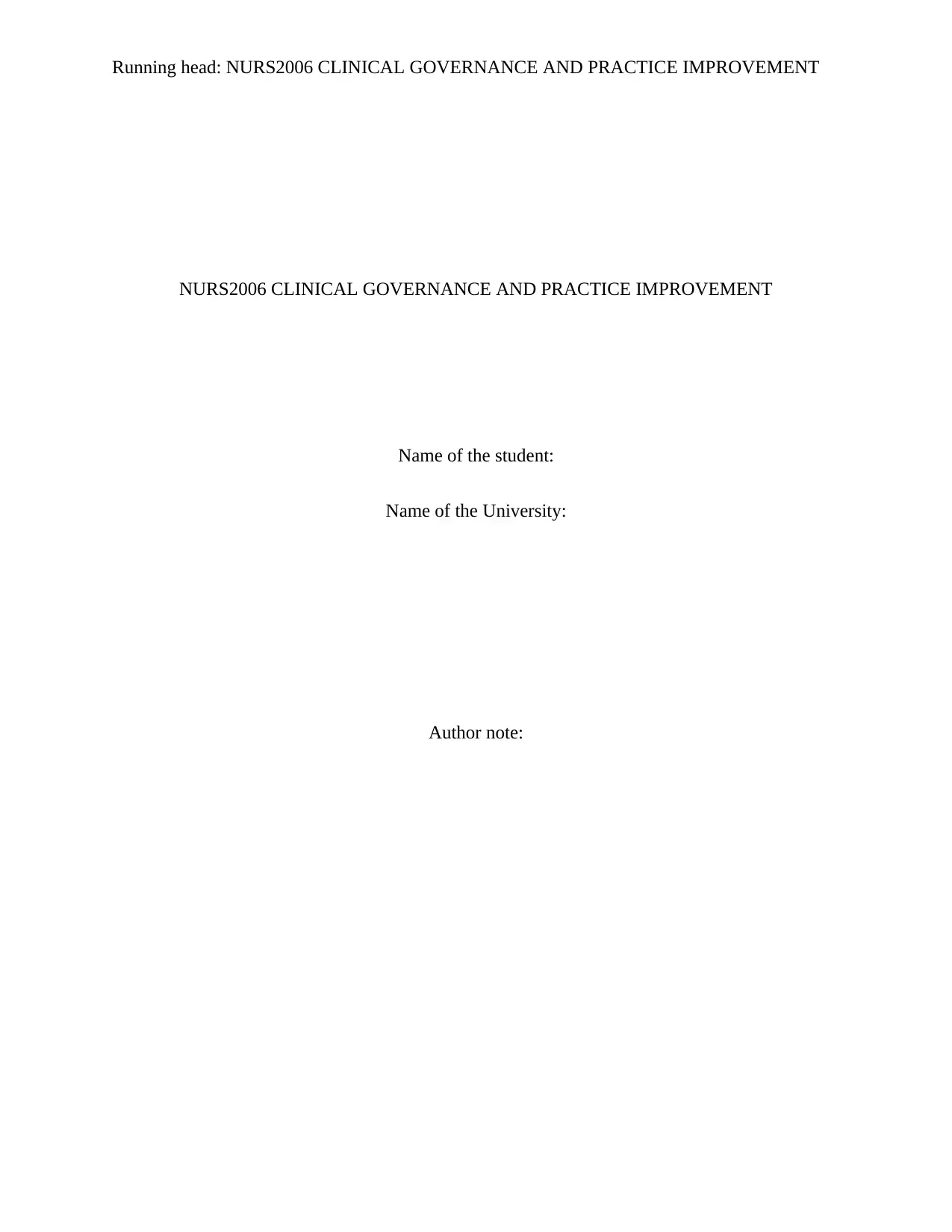
Running head: NURS2006 CLINICAL GOVERNANCE AND PRACTICE IMPROVEMENT
NURS2006 CLINICAL GOVERNANCE AND PRACTICE IMPROVEMENT
Name of the student:
Name of the University:
Author note:
NURS2006 CLINICAL GOVERNANCE AND PRACTICE IMPROVEMENT
Name of the student:
Name of the University:
Author note:
Paraphrase This Document
Need a fresh take? Get an instant paraphrase of this document with our AI Paraphraser
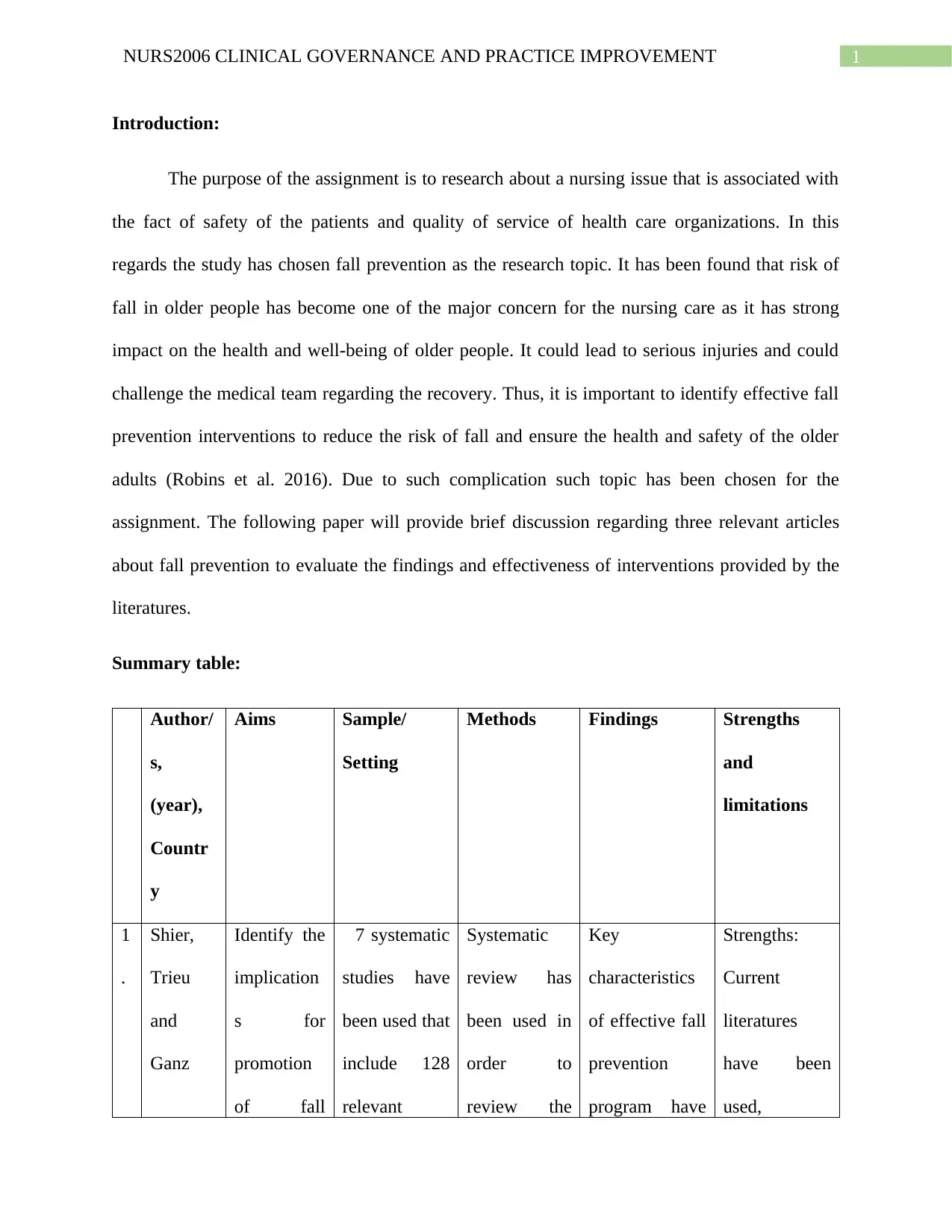
1NURS2006 CLINICAL GOVERNANCE AND PRACTICE IMPROVEMENT
Introduction:
The purpose of the assignment is to research about a nursing issue that is associated with
the fact of safety of the patients and quality of service of health care organizations. In this
regards the study has chosen fall prevention as the research topic. It has been found that risk of
fall in older people has become one of the major concern for the nursing care as it has strong
impact on the health and well-being of older people. It could lead to serious injuries and could
challenge the medical team regarding the recovery. Thus, it is important to identify effective fall
prevention interventions to reduce the risk of fall and ensure the health and safety of the older
adults (Robins et al. 2016). Due to such complication such topic has been chosen for the
assignment. The following paper will provide brief discussion regarding three relevant articles
about fall prevention to evaluate the findings and effectiveness of interventions provided by the
literatures.
Summary table:
Author/
s,
(year),
Countr
y
Aims Sample/
Setting
Methods Findings Strengths
and
limitations
1
.
Shier,
Trieu
and
Ganz
Identify the
implication
s for
promotion
of fall
7 systematic
studies have
been used that
include 128
relevant
Systematic
review has
been used in
order to
review the
Key
characteristics
of effective fall
prevention
program have
Strengths:
Current
literatures
have been
used,
Introduction:
The purpose of the assignment is to research about a nursing issue that is associated with
the fact of safety of the patients and quality of service of health care organizations. In this
regards the study has chosen fall prevention as the research topic. It has been found that risk of
fall in older people has become one of the major concern for the nursing care as it has strong
impact on the health and well-being of older people. It could lead to serious injuries and could
challenge the medical team regarding the recovery. Thus, it is important to identify effective fall
prevention interventions to reduce the risk of fall and ensure the health and safety of the older
adults (Robins et al. 2016). Due to such complication such topic has been chosen for the
assignment. The following paper will provide brief discussion regarding three relevant articles
about fall prevention to evaluate the findings and effectiveness of interventions provided by the
literatures.
Summary table:
Author/
s,
(year),
Countr
y
Aims Sample/
Setting
Methods Findings Strengths
and
limitations
1
.
Shier,
Trieu
and
Ganz
Identify the
implication
s for
promotion
of fall
7 systematic
studies have
been used that
include 128
relevant
Systematic
review has
been used in
order to
review the
Key
characteristics
of effective fall
prevention
program have
Strengths:
Current
literatures
have been
used,
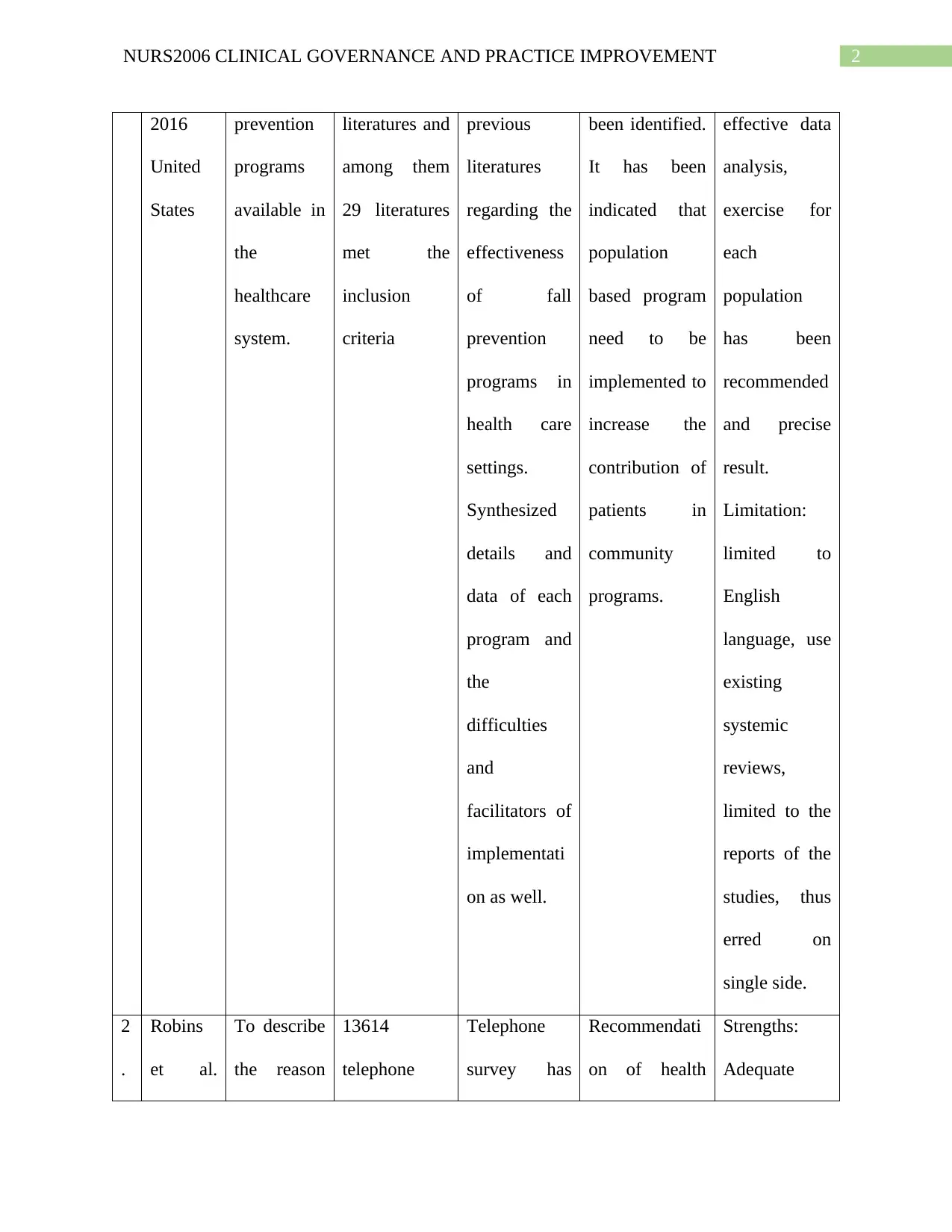
2NURS2006 CLINICAL GOVERNANCE AND PRACTICE IMPROVEMENT
2016
United
States
prevention
programs
available in
the
healthcare
system.
literatures and
among them
29 literatures
met the
inclusion
criteria
previous
literatures
regarding the
effectiveness
of fall
prevention
programs in
health care
settings.
Synthesized
details and
data of each
program and
the
difficulties
and
facilitators of
implementati
on as well.
been identified.
It has been
indicated that
population
based program
need to be
implemented to
increase the
contribution of
patients in
community
programs.
effective data
analysis,
exercise for
each
population
has been
recommended
and precise
result.
Limitation:
limited to
English
language, use
existing
systemic
reviews,
limited to the
reports of the
studies, thus
erred on
single side.
2
.
Robins
et al.
To describe
the reason
13614
telephone
Telephone
survey has
Recommendati
on of health
Strengths:
Adequate
2016
United
States
prevention
programs
available in
the
healthcare
system.
literatures and
among them
29 literatures
met the
inclusion
criteria
previous
literatures
regarding the
effectiveness
of fall
prevention
programs in
health care
settings.
Synthesized
details and
data of each
program and
the
difficulties
and
facilitators of
implementati
on as well.
been identified.
It has been
indicated that
population
based program
need to be
implemented to
increase the
contribution of
patients in
community
programs.
effective data
analysis,
exercise for
each
population
has been
recommended
and precise
result.
Limitation:
limited to
English
language, use
existing
systemic
reviews,
limited to the
reports of the
studies, thus
erred on
single side.
2
.
Robins
et al.
To describe
the reason
13614
telephone
Telephone
survey has
Recommendati
on of health
Strengths:
Adequate
⊘ This is a preview!⊘
Do you want full access?
Subscribe today to unlock all pages.

Trusted by 1+ million students worldwide
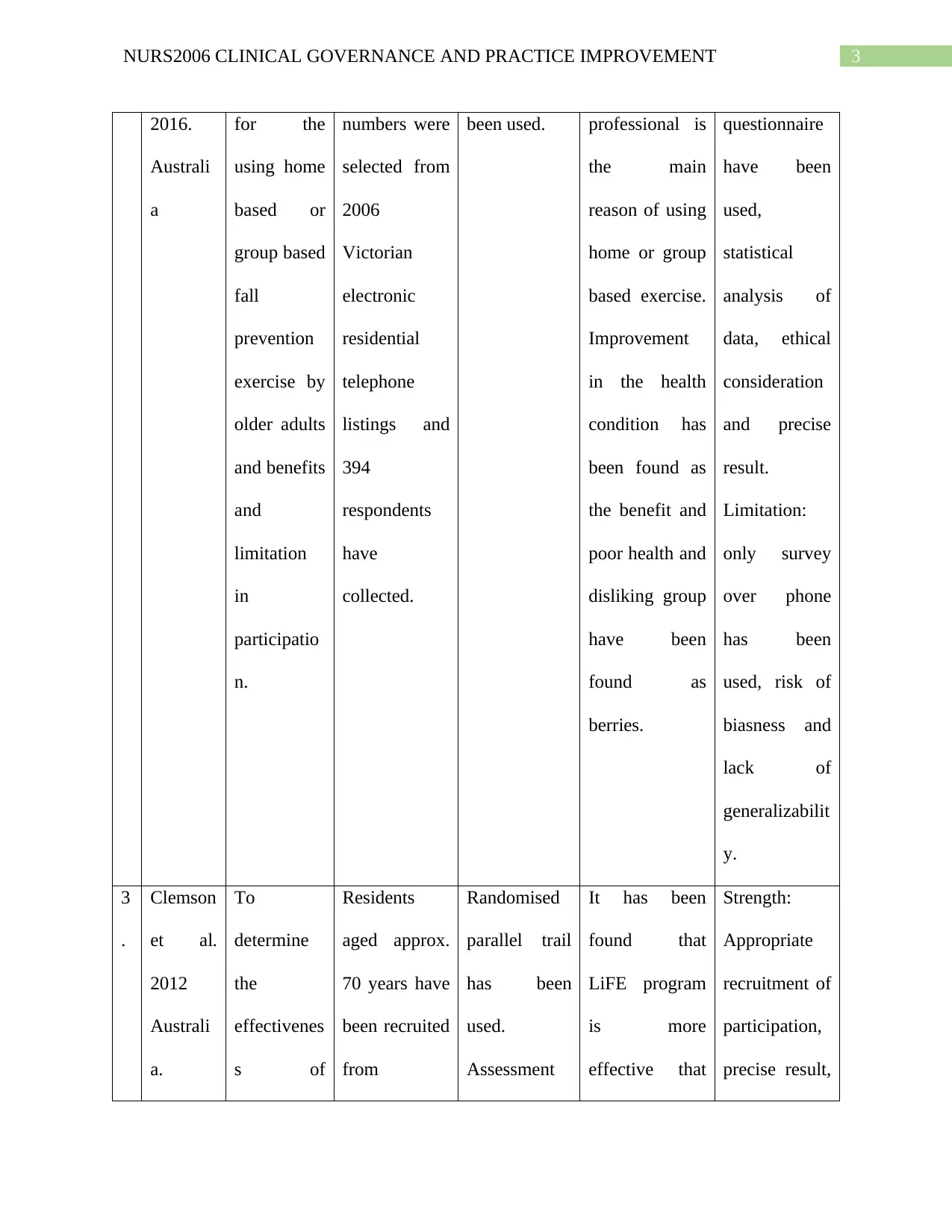
3NURS2006 CLINICAL GOVERNANCE AND PRACTICE IMPROVEMENT
2016.
Australi
a
for the
using home
based or
group based
fall
prevention
exercise by
older adults
and benefits
and
limitation
in
participatio
n.
numbers were
selected from
2006
Victorian
electronic
residential
telephone
listings and
394
respondents
have
collected.
been used. professional is
the main
reason of using
home or group
based exercise.
Improvement
in the health
condition has
been found as
the benefit and
poor health and
disliking group
have been
found as
berries.
questionnaire
have been
used,
statistical
analysis of
data, ethical
consideration
and precise
result.
Limitation:
only survey
over phone
has been
used, risk of
biasness and
lack of
generalizabilit
y.
3
.
Clemson
et al.
2012
Australi
a.
To
determine
the
effectivenes
s of
Residents
aged approx.
70 years have
been recruited
from
Randomised
parallel trail
has been
used.
Assessment
It has been
found that
LiFE program
is more
effective that
Strength:
Appropriate
recruitment of
participation,
precise result,
2016.
Australi
a
for the
using home
based or
group based
fall
prevention
exercise by
older adults
and benefits
and
limitation
in
participatio
n.
numbers were
selected from
2006
Victorian
electronic
residential
telephone
listings and
394
respondents
have
collected.
been used. professional is
the main
reason of using
home or group
based exercise.
Improvement
in the health
condition has
been found as
the benefit and
poor health and
disliking group
have been
found as
berries.
questionnaire
have been
used,
statistical
analysis of
data, ethical
consideration
and precise
result.
Limitation:
only survey
over phone
has been
used, risk of
biasness and
lack of
generalizabilit
y.
3
.
Clemson
et al.
2012
Australi
a.
To
determine
the
effectivenes
s of
Residents
aged approx.
70 years have
been recruited
from
Randomised
parallel trail
has been
used.
Assessment
It has been
found that
LiFE program
is more
effective that
Strength:
Appropriate
recruitment of
participation,
precise result,
Paraphrase This Document
Need a fresh take? Get an instant paraphrase of this document with our AI Paraphraser
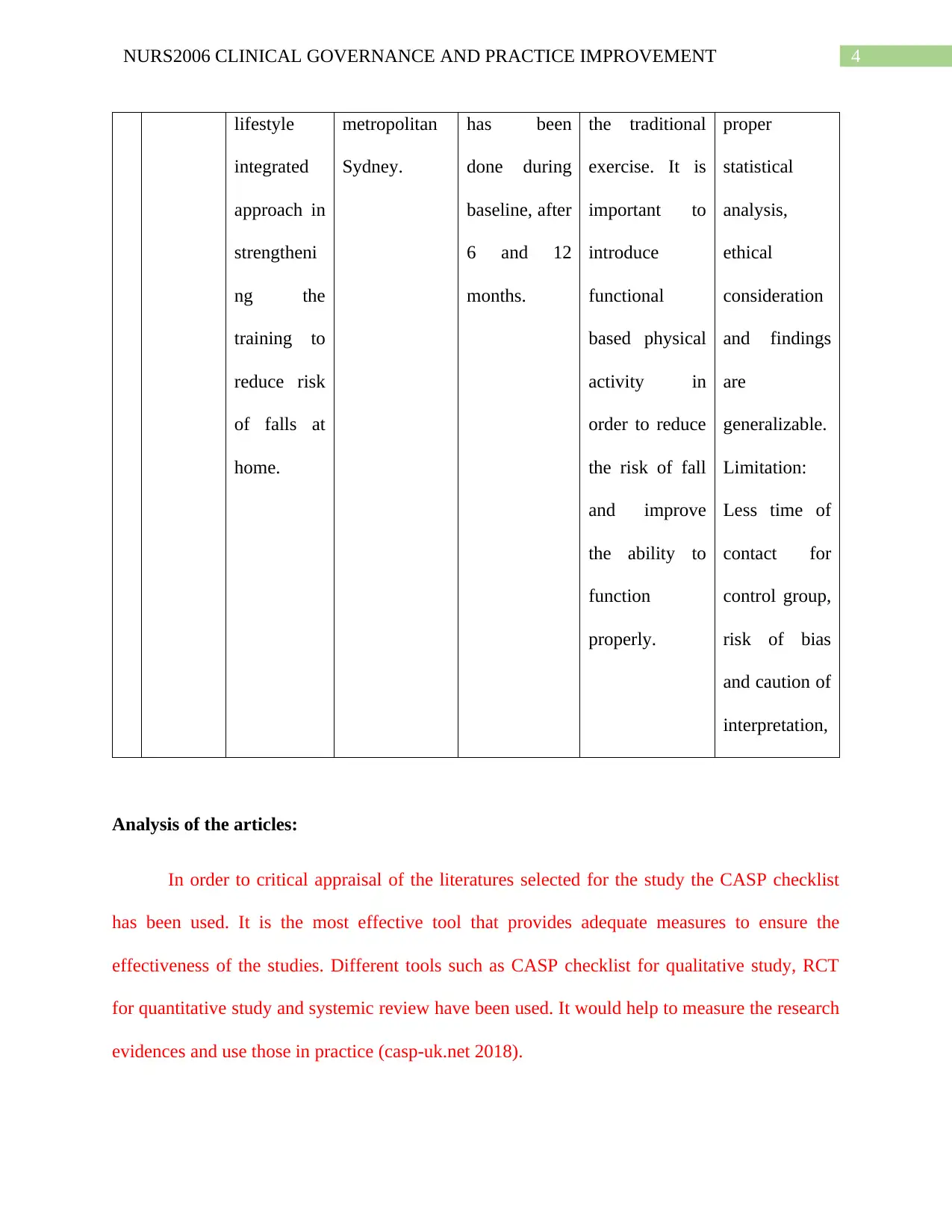
4NURS2006 CLINICAL GOVERNANCE AND PRACTICE IMPROVEMENT
lifestyle
integrated
approach in
strengtheni
ng the
training to
reduce risk
of falls at
home.
metropolitan
Sydney.
has been
done during
baseline, after
6 and 12
months.
the traditional
exercise. It is
important to
introduce
functional
based physical
activity in
order to reduce
the risk of fall
and improve
the ability to
function
properly.
proper
statistical
analysis,
ethical
consideration
and findings
are
generalizable.
Limitation:
Less time of
contact for
control group,
risk of bias
and caution of
interpretation,
Analysis of the articles:
In order to critical appraisal of the literatures selected for the study the CASP checklist
has been used. It is the most effective tool that provides adequate measures to ensure the
effectiveness of the studies. Different tools such as CASP checklist for qualitative study, RCT
for quantitative study and systemic review have been used. It would help to measure the research
evidences and use those in practice (casp-uk.net 2018).
lifestyle
integrated
approach in
strengtheni
ng the
training to
reduce risk
of falls at
home.
metropolitan
Sydney.
has been
done during
baseline, after
6 and 12
months.
the traditional
exercise. It is
important to
introduce
functional
based physical
activity in
order to reduce
the risk of fall
and improve
the ability to
function
properly.
proper
statistical
analysis,
ethical
consideration
and findings
are
generalizable.
Limitation:
Less time of
contact for
control group,
risk of bias
and caution of
interpretation,
Analysis of the articles:
In order to critical appraisal of the literatures selected for the study the CASP checklist
has been used. It is the most effective tool that provides adequate measures to ensure the
effectiveness of the studies. Different tools such as CASP checklist for qualitative study, RCT
for quantitative study and systemic review have been used. It would help to measure the research
evidences and use those in practice (casp-uk.net 2018).
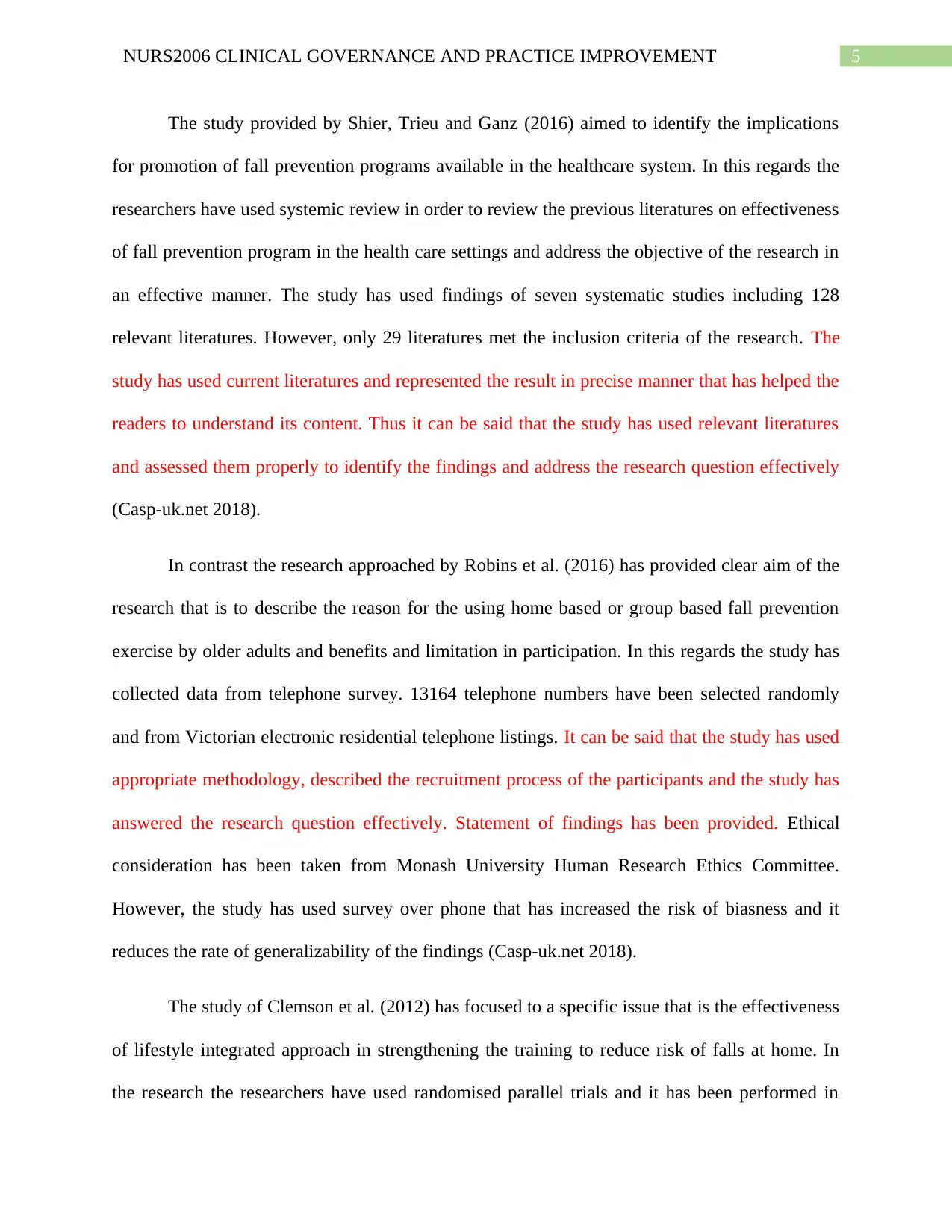
5NURS2006 CLINICAL GOVERNANCE AND PRACTICE IMPROVEMENT
The study provided by Shier, Trieu and Ganz (2016) aimed to identify the implications
for promotion of fall prevention programs available in the healthcare system. In this regards the
researchers have used systemic review in order to review the previous literatures on effectiveness
of fall prevention program in the health care settings and address the objective of the research in
an effective manner. The study has used findings of seven systematic studies including 128
relevant literatures. However, only 29 literatures met the inclusion criteria of the research. The
study has used current literatures and represented the result in precise manner that has helped the
readers to understand its content. Thus it can be said that the study has used relevant literatures
and assessed them properly to identify the findings and address the research question effectively
(Casp-uk.net 2018).
In contrast the research approached by Robins et al. (2016) has provided clear aim of the
research that is to describe the reason for the using home based or group based fall prevention
exercise by older adults and benefits and limitation in participation. In this regards the study has
collected data from telephone survey. 13164 telephone numbers have been selected randomly
and from Victorian electronic residential telephone listings. It can be said that the study has used
appropriate methodology, described the recruitment process of the participants and the study has
answered the research question effectively. Statement of findings has been provided. Ethical
consideration has been taken from Monash University Human Research Ethics Committee.
However, the study has used survey over phone that has increased the risk of biasness and it
reduces the rate of generalizability of the findings (Casp-uk.net 2018).
The study of Clemson et al. (2012) has focused to a specific issue that is the effectiveness
of lifestyle integrated approach in strengthening the training to reduce risk of falls at home. In
the research the researchers have used randomised parallel trials and it has been performed in
The study provided by Shier, Trieu and Ganz (2016) aimed to identify the implications
for promotion of fall prevention programs available in the healthcare system. In this regards the
researchers have used systemic review in order to review the previous literatures on effectiveness
of fall prevention program in the health care settings and address the objective of the research in
an effective manner. The study has used findings of seven systematic studies including 128
relevant literatures. However, only 29 literatures met the inclusion criteria of the research. The
study has used current literatures and represented the result in precise manner that has helped the
readers to understand its content. Thus it can be said that the study has used relevant literatures
and assessed them properly to identify the findings and address the research question effectively
(Casp-uk.net 2018).
In contrast the research approached by Robins et al. (2016) has provided clear aim of the
research that is to describe the reason for the using home based or group based fall prevention
exercise by older adults and benefits and limitation in participation. In this regards the study has
collected data from telephone survey. 13164 telephone numbers have been selected randomly
and from Victorian electronic residential telephone listings. It can be said that the study has used
appropriate methodology, described the recruitment process of the participants and the study has
answered the research question effectively. Statement of findings has been provided. Ethical
consideration has been taken from Monash University Human Research Ethics Committee.
However, the study has used survey over phone that has increased the risk of biasness and it
reduces the rate of generalizability of the findings (Casp-uk.net 2018).
The study of Clemson et al. (2012) has focused to a specific issue that is the effectiveness
of lifestyle integrated approach in strengthening the training to reduce risk of falls at home. In
the research the researchers have used randomised parallel trials and it has been performed in
⊘ This is a preview!⊘
Do you want full access?
Subscribe today to unlock all pages.

Trusted by 1+ million students worldwide
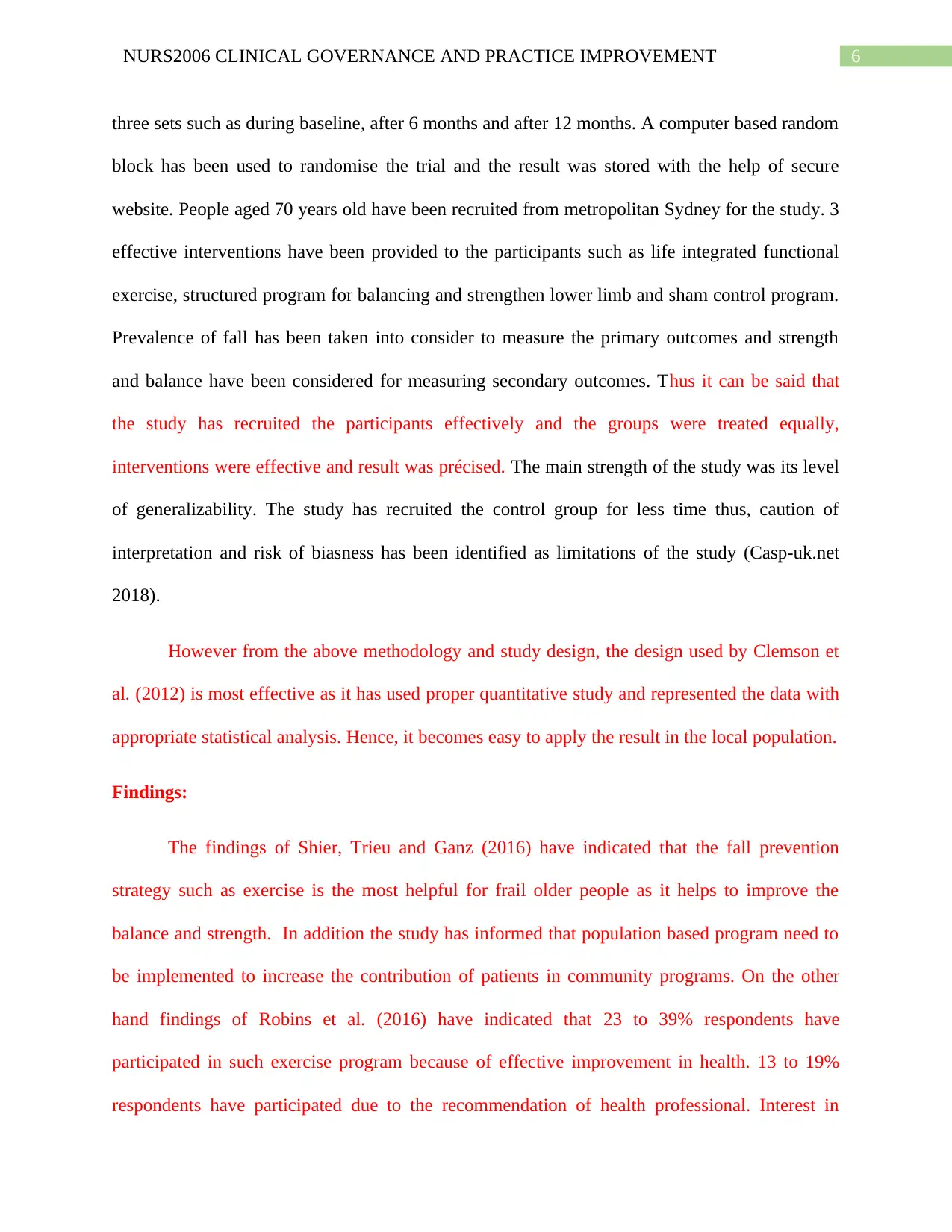
6NURS2006 CLINICAL GOVERNANCE AND PRACTICE IMPROVEMENT
three sets such as during baseline, after 6 months and after 12 months. A computer based random
block has been used to randomise the trial and the result was stored with the help of secure
website. People aged 70 years old have been recruited from metropolitan Sydney for the study. 3
effective interventions have been provided to the participants such as life integrated functional
exercise, structured program for balancing and strengthen lower limb and sham control program.
Prevalence of fall has been taken into consider to measure the primary outcomes and strength
and balance have been considered for measuring secondary outcomes. Thus it can be said that
the study has recruited the participants effectively and the groups were treated equally,
interventions were effective and result was précised. The main strength of the study was its level
of generalizability. The study has recruited the control group for less time thus, caution of
interpretation and risk of biasness has been identified as limitations of the study (Casp-uk.net
2018).
However from the above methodology and study design, the design used by Clemson et
al. (2012) is most effective as it has used proper quantitative study and represented the data with
appropriate statistical analysis. Hence, it becomes easy to apply the result in the local population.
Findings:
The findings of Shier, Trieu and Ganz (2016) have indicated that the fall prevention
strategy such as exercise is the most helpful for frail older people as it helps to improve the
balance and strength. In addition the study has informed that population based program need to
be implemented to increase the contribution of patients in community programs. On the other
hand findings of Robins et al. (2016) have indicated that 23 to 39% respondents have
participated in such exercise program because of effective improvement in health. 13 to 19%
respondents have participated due to the recommendation of health professional. Interest in
three sets such as during baseline, after 6 months and after 12 months. A computer based random
block has been used to randomise the trial and the result was stored with the help of secure
website. People aged 70 years old have been recruited from metropolitan Sydney for the study. 3
effective interventions have been provided to the participants such as life integrated functional
exercise, structured program for balancing and strengthen lower limb and sham control program.
Prevalence of fall has been taken into consider to measure the primary outcomes and strength
and balance have been considered for measuring secondary outcomes. Thus it can be said that
the study has recruited the participants effectively and the groups were treated equally,
interventions were effective and result was précised. The main strength of the study was its level
of generalizability. The study has recruited the control group for less time thus, caution of
interpretation and risk of biasness has been identified as limitations of the study (Casp-uk.net
2018).
However from the above methodology and study design, the design used by Clemson et
al. (2012) is most effective as it has used proper quantitative study and represented the data with
appropriate statistical analysis. Hence, it becomes easy to apply the result in the local population.
Findings:
The findings of Shier, Trieu and Ganz (2016) have indicated that the fall prevention
strategy such as exercise is the most helpful for frail older people as it helps to improve the
balance and strength. In addition the study has informed that population based program need to
be implemented to increase the contribution of patients in community programs. On the other
hand findings of Robins et al. (2016) have indicated that 23 to 39% respondents have
participated in such exercise program because of effective improvement in health. 13 to 19%
respondents have participated due to the recommendation of health professional. Interest in
Paraphrase This Document
Need a fresh take? Get an instant paraphrase of this document with our AI Paraphraser
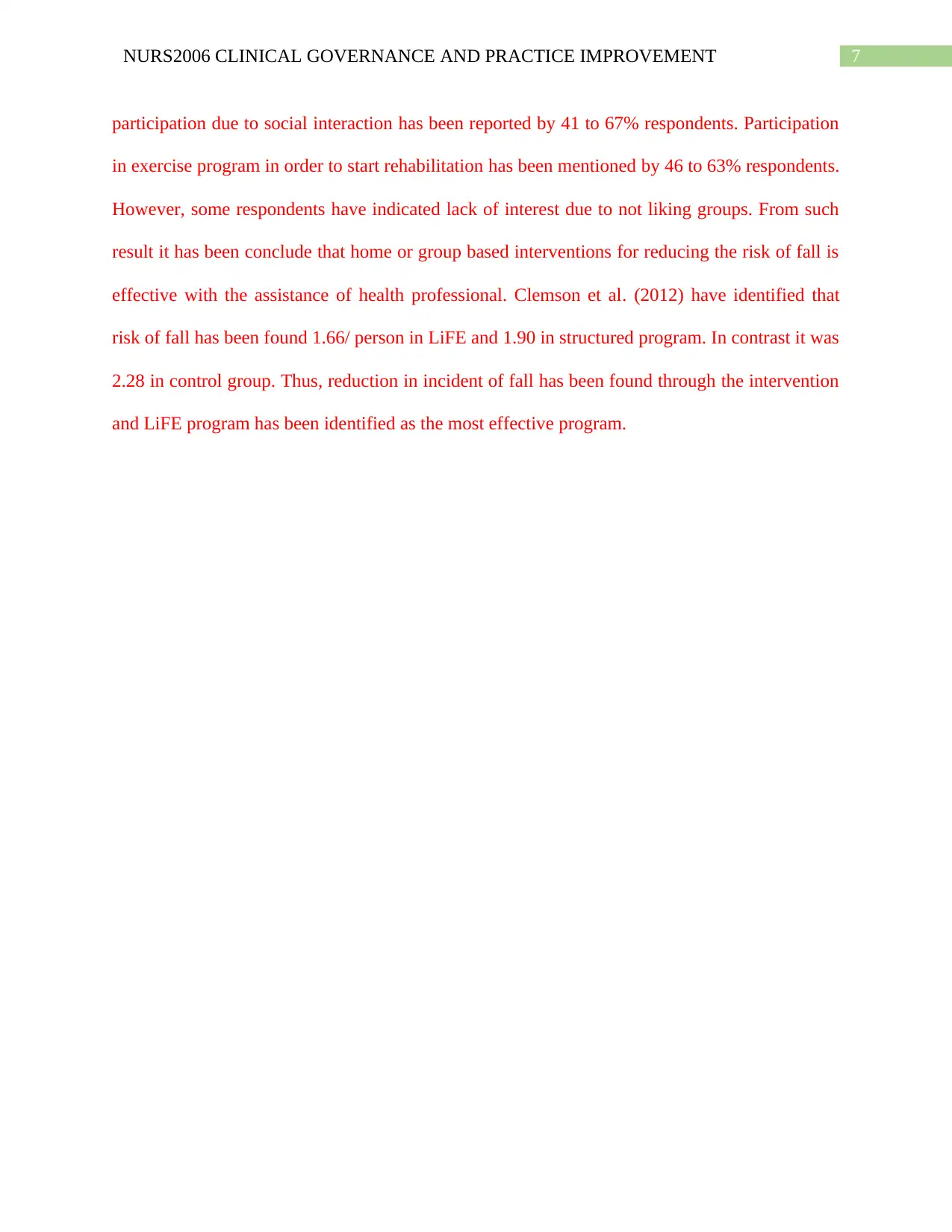
7NURS2006 CLINICAL GOVERNANCE AND PRACTICE IMPROVEMENT
participation due to social interaction has been reported by 41 to 67% respondents. Participation
in exercise program in order to start rehabilitation has been mentioned by 46 to 63% respondents.
However, some respondents have indicated lack of interest due to not liking groups. From such
result it has been conclude that home or group based interventions for reducing the risk of fall is
effective with the assistance of health professional. Clemson et al. (2012) have identified that
risk of fall has been found 1.66/ person in LiFE and 1.90 in structured program. In contrast it was
2.28 in control group. Thus, reduction in incident of fall has been found through the intervention
and LiFE program has been identified as the most effective program.
participation due to social interaction has been reported by 41 to 67% respondents. Participation
in exercise program in order to start rehabilitation has been mentioned by 46 to 63% respondents.
However, some respondents have indicated lack of interest due to not liking groups. From such
result it has been conclude that home or group based interventions for reducing the risk of fall is
effective with the assistance of health professional. Clemson et al. (2012) have identified that
risk of fall has been found 1.66/ person in LiFE and 1.90 in structured program. In contrast it was
2.28 in control group. Thus, reduction in incident of fall has been found through the intervention
and LiFE program has been identified as the most effective program.
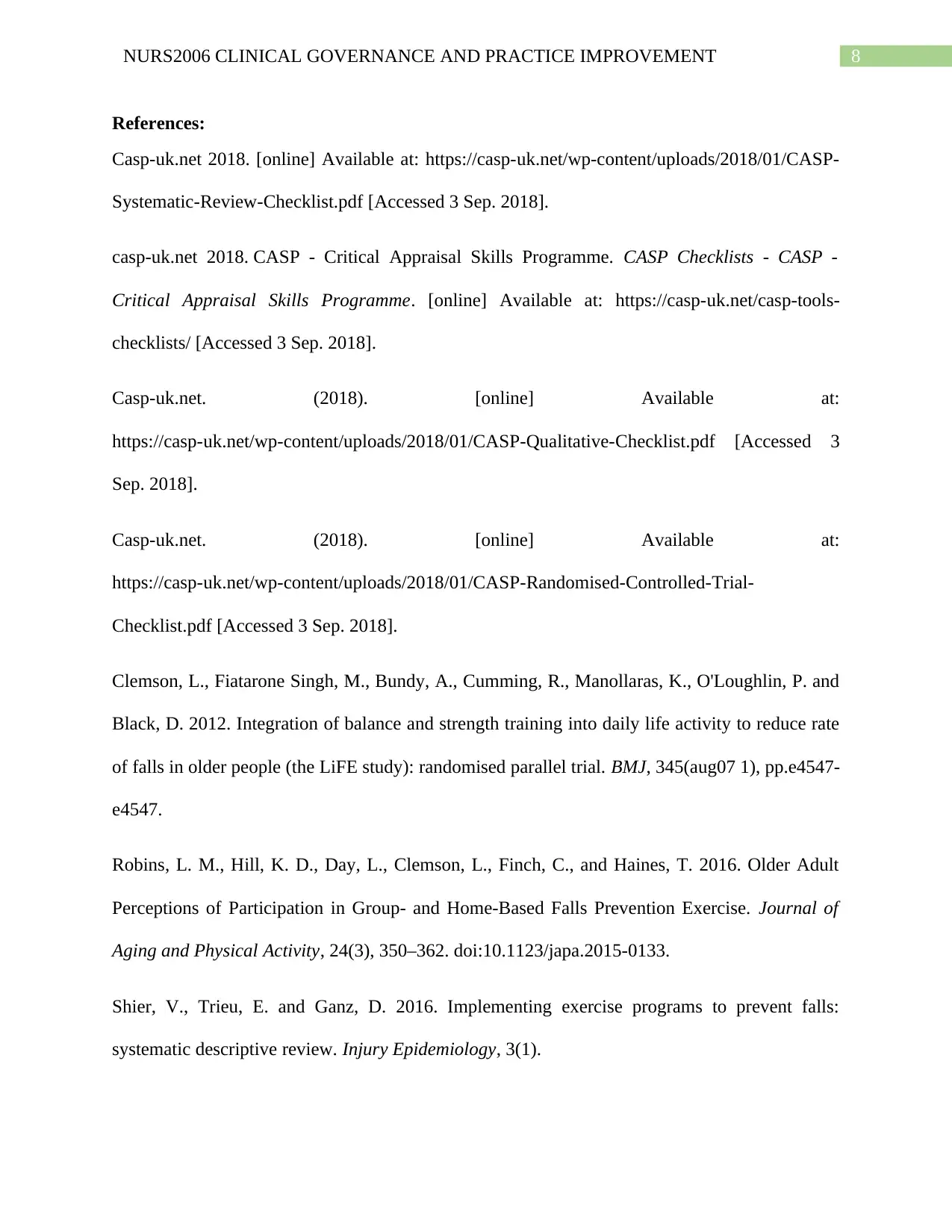
8NURS2006 CLINICAL GOVERNANCE AND PRACTICE IMPROVEMENT
References:
Casp-uk.net 2018. [online] Available at: https://casp-uk.net/wp-content/uploads/2018/01/CASP-
Systematic-Review-Checklist.pdf [Accessed 3 Sep. 2018].
casp-uk.net 2018. CASP - Critical Appraisal Skills Programme. CASP Checklists - CASP -
Critical Appraisal Skills Programme. [online] Available at: https://casp-uk.net/casp-tools-
checklists/ [Accessed 3 Sep. 2018].
Casp-uk.net. (2018). [online] Available at:
https://casp-uk.net/wp-content/uploads/2018/01/CASP-Qualitative-Checklist.pdf [Accessed 3
Sep. 2018].
Casp-uk.net. (2018). [online] Available at:
https://casp-uk.net/wp-content/uploads/2018/01/CASP-Randomised-Controlled-Trial-
Checklist.pdf [Accessed 3 Sep. 2018].
Clemson, L., Fiatarone Singh, M., Bundy, A., Cumming, R., Manollaras, K., O'Loughlin, P. and
Black, D. 2012. Integration of balance and strength training into daily life activity to reduce rate
of falls in older people (the LiFE study): randomised parallel trial. BMJ, 345(aug07 1), pp.e4547-
e4547.
Robins, L. M., Hill, K. D., Day, L., Clemson, L., Finch, C., and Haines, T. 2016. Older Adult
Perceptions of Participation in Group- and Home-Based Falls Prevention Exercise. Journal of
Aging and Physical Activity, 24(3), 350–362. doi:10.1123/japa.2015-0133.
Shier, V., Trieu, E. and Ganz, D. 2016. Implementing exercise programs to prevent falls:
systematic descriptive review. Injury Epidemiology, 3(1).
References:
Casp-uk.net 2018. [online] Available at: https://casp-uk.net/wp-content/uploads/2018/01/CASP-
Systematic-Review-Checklist.pdf [Accessed 3 Sep. 2018].
casp-uk.net 2018. CASP - Critical Appraisal Skills Programme. CASP Checklists - CASP -
Critical Appraisal Skills Programme. [online] Available at: https://casp-uk.net/casp-tools-
checklists/ [Accessed 3 Sep. 2018].
Casp-uk.net. (2018). [online] Available at:
https://casp-uk.net/wp-content/uploads/2018/01/CASP-Qualitative-Checklist.pdf [Accessed 3
Sep. 2018].
Casp-uk.net. (2018). [online] Available at:
https://casp-uk.net/wp-content/uploads/2018/01/CASP-Randomised-Controlled-Trial-
Checklist.pdf [Accessed 3 Sep. 2018].
Clemson, L., Fiatarone Singh, M., Bundy, A., Cumming, R., Manollaras, K., O'Loughlin, P. and
Black, D. 2012. Integration of balance and strength training into daily life activity to reduce rate
of falls in older people (the LiFE study): randomised parallel trial. BMJ, 345(aug07 1), pp.e4547-
e4547.
Robins, L. M., Hill, K. D., Day, L., Clemson, L., Finch, C., and Haines, T. 2016. Older Adult
Perceptions of Participation in Group- and Home-Based Falls Prevention Exercise. Journal of
Aging and Physical Activity, 24(3), 350–362. doi:10.1123/japa.2015-0133.
Shier, V., Trieu, E. and Ganz, D. 2016. Implementing exercise programs to prevent falls:
systematic descriptive review. Injury Epidemiology, 3(1).
⊘ This is a preview!⊘
Do you want full access?
Subscribe today to unlock all pages.

Trusted by 1+ million students worldwide
1 out of 9
Related Documents
Your All-in-One AI-Powered Toolkit for Academic Success.
+13062052269
info@desklib.com
Available 24*7 on WhatsApp / Email
![[object Object]](/_next/static/media/star-bottom.7253800d.svg)
Unlock your academic potential
Copyright © 2020–2025 A2Z Services. All Rights Reserved. Developed and managed by ZUCOL.





